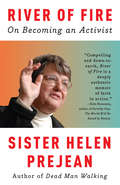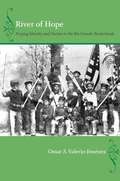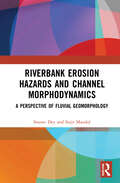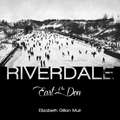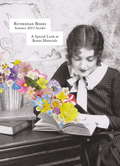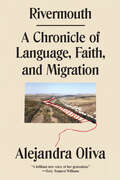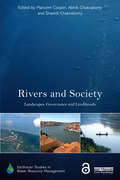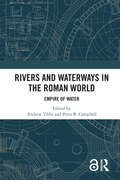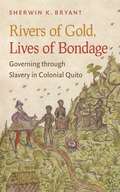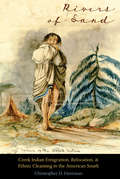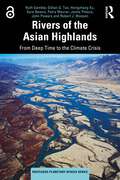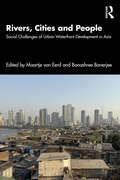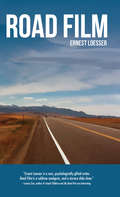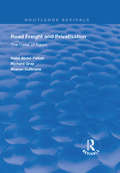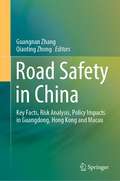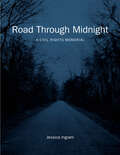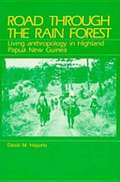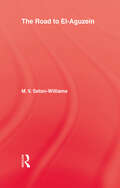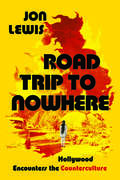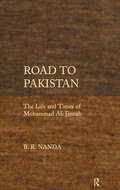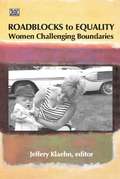- Table View
- List View
River of Fire: My Spiritual Journey
by Helen Prejean“River of Fire is Sister Helen’s story leading up to her acclaimed book Dead Man Walking—it is thought-provoking, informative, and inspiring. Read it and it will set your heart ablaze!”—Mark Shriver, author of Pilgrimage: My Search for the Real Pope Francis The nation’s foremost leader in efforts to abolish the death penalty shares the story of her growth as a spiritual leader, speaks out about the challenges of the Catholic Church, and shows that joy and religion are not mutually exclusive. Sister Helen Prejean’s work as an activist nun, campaigning to educate Americans about the inhumanity of the death penalty, is known to millions worldwide. Less widely known is the evolution of her spiritual journey from praying for God to solve the world’s problems to engaging full-tilt in working to transform societal injustices. Sister Helen grew up in a well-off Baton Rouge family that still employed black servants. She joined the Sisters of St. Joseph at the age of eighteen and was in her forties when she had an awakening that her life’s work was to immerse herself in the struggle of poor people forced to live on the margins of society. Sister Helen writes about the relationships with friends, fellow nuns, and mentors who have shaped her over the years. In this honest and fiercely open account, she writes about her close friendship with a priest, intent on marrying her, that challenged her vocation in the “new territory of the heart.” The final page of River of Fire ends with the opening page of Dead Man Walking, when she was first invited to correspond with a man on Louisiana’s death row. River of Fire is a book for anyone interested in journeys of faith and spirituality, doubt and belief, and “catching on fire” to purpose and passion. It is a book, written in accessible, luminous prose, about how to live a spiritual life that is wide awake to the sufferings and creative opportunities of our world.“Prejean chronicles the compelling, sometimes-difficult journey to the heart of her soul and faith with wit, honesty, and intelligence. A refreshingly intimate memoir of a life in faith.”—Kirkus Reviews
River of Hope: Forging Identity and Nation in the Rio Grande Borderlands
by Omar S. Valerio-JiménezIn River of Hope, Omar S. Valerio-Jiménez examines state formation, cultural change, and the construction of identity in the lower Rio Grande region during the eighteenth and nineteenth centuries. He chronicles a history of violence resulting from multiple conquests, of resistance and accommodation to state power, and of changing ethnic and political identities. The redrawing of borders neither began nor ended the region's long history of unequal power relations. Nor did it lead residents to adopt singular colonial or national identities. Instead, their regionalism, transnational cultural practices, and kinship ties subverted state attempts to control and divide the population.Diverse influences transformed the borderlands as Spain, Mexico, and the United States competed for control of the region. Indian slaves joined Spanish society; Mexicans allied with Indians to defend river communities; Anglo Americans and Mexicans intermarried and collaborated; and women sued to confront spousal abuse and to secure divorces. Drawn into multiple conflicts along the border, Mexican nationals and Mexican Texans (tejanos) took advantage of their transnational social relations and ambiguous citizenship to escape criminal prosecution, secure political refuge, and obtain economic opportunities. To confront the racialization of their cultural practices and their increasing criminalization, tejanos claimed citizenship rights within the United States and, in the process, created a new identity.Published in cooperation with the William P. Clements Center for Southwest Studies, Southern Methodist University.
River of Ink: [An Illustrated History of Literacy]
by Thomas ChristensenThomas Christensen's previous title 1616: The World in Motion looked at a single year in the age of early maritime globalism--PW gave it a starred review, calling it "a stunning overview of the nascent modern world." By contrast his new gorgeously illustrated River of Ink ranges widely across time and cultures and offers what amounts to a magisterial history of literacy.The book's title refers to the sacking of Baghdad in 1258 when the Tigris ran black with the ink of books flung into the water by Mongol invaders. Other essays range from the writings of prehistoric Chinese cultures known only through archaeology to the state of book reviewing in the US today to the heroic efforts of contemporary Afghanis to keep the legacy of their ancient culture alive under the barrage of endless war.Christensen's encyclopaedic knowledge of both world art and a vast understand of literature allows him to move easily from a discussion of the invention of moveable type in Korea to Johannes Kepler's search for the harmony of the spheres to the strange journey of an iron sculpture from Benin to the Louvre. Other essays cover the Popul Vuh of the Maya as exemplum of translation, the pioneering explorations of the early American naturalist John Bartram, the balletic works of Louis-Ferdinand Celine.It is Christensen's unparalleled gift to seemingly see the world whole and to offer a wealth of absolutely vital connections adequate to our position as citizens of an ever more rapidly globalizing world.
Riverbank Erosion Hazards and Channel Morphodynamics: A Perspective of Fluvial Geomorphology
by Sujit Mandal Sourav DeyThis book explores fluvial processes and their consequences on river dynamics in India. It discusses the integration of geomorphic, hydrologic, and socio-economic data with various policies and decisions regarding sustainable river basin management. The volume looks at the origin and development of streams, chronology of fluvial geomorphology, fluvial system concept, process–form interaction, river dynamics, channel migration, flow regime, channel types, and hydraulic and morphometric parameters; and explains how changing hydro-geomorphological dynamics have influenced land use patterns, nature of fluids, behaviour of floods, etc. It examines channel migration vulnerability and bank erosion hazard vulnerability of the Torsa River in the eastern region of India as a case study using channel migration zone and Bank Erosion Hazard Index models. The book presents a new research framework based on field surveys, scientific investigations, and analytical techniques and methods to interpret key geoinformatics data. With its extensive illustrations, this book will be useful to students, teachers, and researchers of geography, earth sciences, environmental geology, and environment and disaster management. It will also interest geographers, civil engineers, hydrologists, geomorphologists, planners, and other individuals and organizations working on fluvial processes and riverbank erosion problems globally.
Riverdale: East of the Don
by Elizabeth Gillan MuirHeritage Toronto Book Award — Shortlisted, Non-Fiction Book A popular history of the Riverdale area of Toronto, including Playter Estates north of the Danforth. In its first 50 years, the city of Toronto changed from a rough settlement to a booming city with a voracious appetite for land. The incorporated city of Toronto grew tenfold from 1834 to 1884 — partly through immigration, but also through the annexation of older communities. Among these were the former suburbs of Leslieville and Riverside, which were joined together in 1884 to become the new Toronto community of Riverdale. Later, the Playter Estates neighbourhood also became part of this community. Riverdale tells the history of the neighbourhood, starting with the Simcoe, Scadding, Playter, and Leslie families, who shaped the area throughout its early settlement, the American Revolution, and the War of 1812. It shows the waves of immigration from Britain, America, Italy, Greece, and China, that made Riverdale one of Toronto’s most diverse areas. And it tells the stories written into the map of the neighbourhood, revealing the history on display in its streets and historic buildings.
Riverhead Books Summer 2013 Insider
by James Mcbride Khaled Hosseini Matthew Berry Riverhead Books Anton DisclafaniRiverhead Books is proud to present our Summer 2013 Insider which gives readers more information about the stories behind--or sometimes from within--our Summer 2013 list. Included in the Riverhead Books Summer 2013 Insider are:A Q&A with Khaled Hosseini, author of And the Mountains Echoed, an unforgettable novel about finding a lost piece of yourself in someone else. An interview with Pransky, the layabout mutt turned therapy dog at the heart of Sue Halpern's A Dog Walks into a Nursing Home: Lessons in the Good Life from an Unlikely Teacher. Ramona Ausubel's essay, "Transformation," about the inspiration for A Guide to Being Born, her enthralling new collection that uses the world of the imagination to explore the heart of the human condition. "The Story in the Mountains," an essay by Anton DiSclafani about writing her debut novel, The Yonahlossee Riding Camp for Girls, a lush, sexy evocative story of family secrets and girls'-school rituals set in the 1930s South. "Looking through the Looking Glass," an essay by Anna Badkhen on how she came to write The World is a Carpet, her unforgettable portrait of a place and people shaped by centuries of art, trade and war. A note from Mark Kurlansky about "Dancing in the Street," the iconic song he uses as a lens to examine the story of the civil rights movement's genesis in his new book, Ready for a Brand New Beat Matthew Berry's essay, "It's Fantasy Sports World, You Just Live in It," about the growing world of fantasy sports and how it has shaped his career and personal life which he details in his new book, Fantasy Life. "Noodles of the Silk Road," a field guide by Jen Lin-Liu, author of On the Noodle Road, in which she immerses herself in a moveable feast of foods and cultures and discovers some surprising truths about commitment, independence, and love A brief history of the historic raid on Harper's Ferry which plays a key role in James McBride's new novel, The Good Lord Bird, the story of a young boy born a slave who joins John Brown's antislavery crusade--and who must pass as a girl to survive. Juan Gabriel Vásquez's essay, "Memories of the Years of Chaos," about how Colombia's recent history informs his new novel, The Sound of Things FallingEach of these pieces is an engaging and informative introduction to these truly wonderful books.
Rivermouth: A Chronicle of Language, Faith, and Migration
by Alejandra OlivaBest Nonfiction of 2023 - Kirkus &“One of the most thoughtful meditations on our nation&’s immigration policy in recent memory." —The Boston GlobeA chronicle of translation, storytelling, and borders as understood through the United States' &“immigration crisis&”In this powerful and deeply felt memoir of translation, storytelling, and borders, Alejandra Oliva, a Mexican-American translator and immigrant justice activist, offers a powerful chronical of her experience interpreting at the US-Mexico border.Having worked with asylum seekers since 2016, she knows all too well the gravity of taking someone's trauma and delivering it to the warped demands of the U.S. immigration system. As Oliva's stunning prose recounts the stories of the people she's met through her work, she also traces her family's long and fluid relationship to the border—each generation born on opposite sides of the Rio Grande. In Rivermouth, Oliva focuses on the physical spaces that make up different phases of immigration, looking at how language and opportunity move through each of them: from the river as the waterway that separates the U.S. and Mexico, to the table as the place over which Oliva prepares asylum seekers for their Credible Fear Interviews, and finally, to the wall as the behemoth imposition that runs along America&’s southernmost border.With lush prose and perceptive insight, Oliva encourages readers to approach the painful questions that this crisis poses with equal parts critique and compassion. By which metrics are we measuring who &“deserves&” American citizenship? What is the point of humanitarian systems that distribute aid conditionally? What do we owe to our most disenfranchised?As investigative and analytical as she is meditative and introspective, sharp as she is lyrical, and incisive as she is compassionate, seasoned interpreter Alejandra Oliva argues for a better world while guiding us through the suffering that makes the fight necessary and the joy that makes it worth fighting for.
Rivers and Society: Landscapes, Governance and Livelihoods (Earthscan Studies in Water Resource Management)
by Malcolm Cooper Abhik Chakraborty Shamik ChakrabortyRivers and their watersheds constitute some of the most dynamic and complex landscapes. Rivers have sustained human communities, and human societies have utilized and altered river flows in a number of ways for millennia. However, the level of human impact on rivers, and on watershed environments, has become acute during the last hundred years or so. This book brings together empirical research and theoretical perspectives on the changing conditions of a range of river basin environments in the contemporary world, including the history and culture of local societies living in these river basins. It provides theoretical insights on the patterns and nature of the interaction between rivers and their use by human communities. The chapters are written from a variety of positions, including environmental science, hydrology, human ecology, urban studies, water management, historical geography, cultural anthropology and tourism studies. The case studies span different geographical regions, providing valuable insight on the multifaceted interactions between rivers and our societies, and on the changing riverscapes in different parts of the world. Specific detailed examples are included from Australia, Brazil, France, India, Iran, Japan, the Netherlands, New Zealand, South Africa, UK and USA.
Rivers and Waterways in the Roman World: Empire of Water
by Andrew Tibbs Peter B. CampbellTaking a broad geographical, temporal, and cross-disciplinary approach, this volume explores new and innovative research which focuses on rivers and waterways from across the Roman world. Rivers and Waterways in the Roman World brings together cross-disciplinary chapters focussing on theoretical approaches, new digital and scientific methods and analytical techniques, and related surveying and excavation case studies to examine the Romans extensive use of rivers and inland waterways around the Empire. Roman seafaring is well studied but this book expands our knowledge of Roman transport, communication and trade networks inland. The book highlights the challenges of archaeological work in the dynamic environments of rivers and waterways and showcases the use of new methodologies, including the increasing availability and accessibility of digital technologies that have led to a growth in the development and application of new archaeological and analytical techniques, as well as the discovery of new archaeological sites, many of which were previously inaccessible. This book is for archaeologists, historians, classicists, and geographers with an interest in the history and archaeology of the Roman Empire.
Rivers and Waterways in the Roman World: Empire of Water
by Andrew Tibbs Peter B. CampbellTaking a broad geographical, temporal, and cross-disciplinary approach, this volume explores new and innovative research which focuses on rivers and waterways from across the Roman world.Rivers and Waterways in the Roman World brings together cross-disciplinary chapters focussing on theoretical approaches, new digital and scientific methods and analytical techniques, and related surveying and excavation case studies to examine the Romans' extensive use of rivers and inland waterways around the Empire. Roman seafaring is well studied, but this book expands our knowledge of Roman transport, communication, and trade networks inland. The book highlights the challenges of archaeological work in the dynamic environments of rivers and waterways and showcases the use of new methodologies, including the increasing availability and accessibility of digital technologies that have led to a growth in the development and application of new archaeological and analytical techniques, as well as the discovery of new archaeological sites, many of which were previously inaccessible.This book is for archaeologists, historians, classicists, and geographers with an interest in the history and archaeology of the Roman Empire.Chapter 15 of this book is freely available as a downloadable Open Access PDF at http://www.taylorfrancis.com under a Creative Commons Attribution-Non Commercial-No Derivatives (CC-BY-NC-ND) 4.0 license.Chapter 4 of this book is freely available as a downloadable Open Access PDF at http://www.taylorfrancis.com under a Creative Commons Attribution(CC-BY) 4.0 license.
Rivers of Gold, Lives of Bondage
by Sherwin K. BryantIn this pioneering study of slavery in colonial Ecuador and southern Colombia--Spain's Kingdom of Quito--Sherwin Bryant argues that the most fundamental dimension of slavery was governance and the extension of imperial power. Bryant shows that enslaved black captives were foundational to sixteenth-century royal claims on the Americas and elemental to the process of Spanish colonization. Following enslaved Africans from their arrival at the Caribbean port of Cartagena through their journey to Quito, Bryant explores how they lived during their captivity, formed kinships and communal affinities, and pressed for justice within a slave-based Catholic sovereign community.In Cartagena, officials branded African captives with the royal insignia and gave them a Catholic baptism, marking slaves as projections of royal authority and majesty. By licensing and governing Quito's slave trade, the crown claimed sovereignty over slavery, new territories, natural resources, and markets. By adjudicating slavery, royal authorities claimed to govern not only slaves but other colonial subjects as well. Expanding the diaspora paradigm beyond the Atlantic, Bryant's history of the Afro-Andes in the early modern world suggests new answers to the question, what is a slave?
Rivers of Sand: Creek Indian Emigration, Relocation, and Ethnic Cleansing in the American South (Indians of the Southeast)
by Christopher D. HavemanAt its height the Creek Nation comprised a collection of multiethnic towns and villages stretching across large parts of Alabama, Georgia, and Florida. By the 1830s, however, the Creeks had lost almost all this territory through treaties and by the unchecked intrusion of white settlers who illegally expropriated Native soil. With the Jackson administration unwilling to aid the Creeks in removing the squatters, the Creek people suffered from dispossession, starvation, and indebtedness. Between the 1825 Treaty of Indian Springs and the forced migrations beginning in 1836, nearly twenty-three thousand Creek Indians were relocated—voluntarily or involuntarily—to Indian Territory. Rivers of Sand fills a substantial gap in scholarship by capturing, for the first time, the full breadth and depth of the Creeks’ collective tragedy during the marches westward, on the Creek home front, and during the first years of resettlement. Unlike the Cherokee Trail of Tears, which was conducted largely at the end of a bayonet, most Creeks were removed through a combination of coercion and negotiation. Hopelessly outnumbered military personnel were forced to make concessions in order to gain the compliance of the headmen and their people. Christopher D. Haveman’s meticulous study uses previously unexamined documents to weave narratives of resistance and survival, making Rivers of Sand an essential addition to the ethnohistory of American Indian removal.
Rivers of the Asian Highlands: From Deep Time to the Climate Crisis (Routledge Planetary Spaces Series)
by John Powers Jamie Pittock Gillian G. Tan Ruth Gamble Robert J. Wasson Hongzhang Xu Sara Beavis Petra MaurerRivers of the Asian Highlands introduces readers to the intersecting headwaters of Asia’s eight largest rivers, focusing on the upper reaches of two river systems: the Brahmaputra’s highland tributaries in the eastern Himalayan Mountains and the Dri Chu (upper Yangzi), which descends from the Tibetan Plateau’s east through the Hengduan Mountains.This book guides its readers through these two rivers’ physical, environmental, cultural, social, and political histories before providing a multifaceted assessment of their present. It uses general and detailed insights from multiple disciplines, including anthropology, conservation, geography, geomorphology, climate science, ecology, history, hydrology, and religious studies. The rivers’ stories explain how the catchments’ hazards—earthquakes, landslides, floods, droughts, and erosion—interact with their energetic, hydrological, ecological, cultural, and social abundance.This book’s multiple cultural and disciplinary perspectives on the rivers will interest anyone who wants to understand the rivers of this critically important region as the environment faces climate change and other ecological crises.
Rivers, Cities and People: Social Challenges of Urban Waterfront Development in Asia
by Banashree Banerjee Maartje Van EerdThis book looks at recent initiatives for river restoration and riverfront development intended to contribute to making Asian cities resilient, inclusive and less polluted. It uses an interdisciplinary perspective to assert that insufficient consideration of social issues in the planning and management of urban riverscapes leads to social exclusion. Utilising diverse entry points and theoretical orientations, every chapter of the volume contributes to the exploration of the way urban river restoration is entwined with questions around urban citizenship, violation of international housing rights, poverty and vulnerability, livelihoods and the use of common property resources. It explores the social aspects of well-known cases and examples of river restoration projects from Asian megacities such as Lahore, Dhaka, Chennai, Ahmedabad, Bangkok, Manila and secondary cities in India. While touching on the technical, ecological and recreational aspects of urban river restoration and riverfront development, the book focuses on social issues related to displacement, contestations around land and water, the right to adequate housing and the interconnected rights to livelihoods, health and food security. Enriched with empirical evidence and theoretical underpinnings, this book will be useful for students, teachers and researchers of urban studies, urban geography, urban planning, urban ecology, sociology, community development and policy and governance. It will also provide valuable case material for practitioners in those disciplines.
Road Expansion in the Peruvian Amazon: The 'Enchantments' of the Manu Road (SpringerBriefs in Latin American Studies)
by Marcela Palomino-Schalscha Eduardo Salazar MoreiraThis book provides in-depth insights into the construction of the first road to reach riparian communities and the main access point to a national park in the Amazonian rain forest. It is based on an ethnographic investigation in Peru’s Manu Province in the Amazon, which explored diverse local attitudes towards the construction of a road in the overlapping buffer zone of two protected areas: the Manu National Park and the Amarakaeri Communal Reserve. The book reveals the applicability of Harvey and Knox’s concept of ‘enchantments of infrastructure’ in the case of first roads, but also makes accessible wider debates in political ecology such as territoriality and frontier development. The promise of first roads sparks feelings of aspiration and anticipation of the advent of development through speedy travel, economic connectivity and political integration. Yet these developments seldom take shape as expected. The author explores the perspectives, social dynamics and political maneuvers that influence first road building processes in the Amazon, which have applicability to experiences and strategies of road development elsewhere.
Road Film
by Ernest LoesserFramed as a cinematic odyssey, Road Film owes its debt to the famous road movies from the 1960s-80s. Every reader rides shotgun on a trajectory into an American imagination full of joy and angst. Loesser's mix of prose and verse displays the best of the tradition of the New Sentence-and his work as a journalist in New York as a young man, post 9/11. The result reassembles all the broken episodes collected along the lost highways of America: discarded and violent news reports, local and violent rumors, and the unverifiable stories passed from one traveler to the next.Much like his previous work, Touched by Lightning, Loesser uses a reportorial instinct to transfigure the recurrent patterns he finds as a poet in the isolated corners of our homeland. Throughout Road Film, the driver races between two coasts; he jumps from the city into the wilderness-always skirting the moribund American suburbs, and though there be familiar faces, the author's route never leads toward that simple place called home.
Road Freight and Privatisation: The Case of Egypt (Routledge Revivals)
by Richard Gray Nabil Abdel-Fattah Sharon CullinaneFirst published in 1999, this volume forms part of the Plymouth Studies in Contemporary Shipping series and focuses on Egyptian road freight privatisation. The series represents a unique collection of papers and edited texts from the leading maritime institute in Western Europe at the University of Plymouth. It covers all aspects of the industry from operations through to the logistical framework that supports the sector. Designed both for practising academics and the shipping and ports industry itself, the series, combining the output from some of the leading academic commentators in the world from the UK, Korea, Germany and Poland, is an original and novel contribution to the maritime debate.
Road Headed West: A 6,000-Mile Cycling Odyssey through North America
by Leon MccarronWhat happens when you swap the nine-to-five for two wheels and a journey of a lifetime? Terrified of the prospect of a life spent behind a desk, without challenge or excitement, Leon takes off to cross America on an overloaded bicycle packed with everything but common sense. Over five months and 6000 miles, he cycled from New York to Seattle and then on to the Mexican border, facing tornados, swollen river crossings, wild roaming buffalo and one hungry black bear along the way. But he also met kind strangers, who offered their food, wisdom, hospitality and even the occasional local history lesson, and learned what happens when you take a chance and follow the scent of adventure. With a sharp eye and a genuine go-where-the-wind-takes-me attitude, McCarron makes for an ideal guide on this cycling adventure. He passes through small towns, rolls up and flies down the winding roads of the Blacks Hills is taken in and fed by strangers, all on a quest to discover the "real” America, and in the process, learn a little about himself. Funny, insightful, and full of life, The Road Headed West will inspire readers to chase their dreams and go off in search of adventure.
Road Safety in China: Key Facts, Risk Analysis, Policy Impacts in Guangdong, Hong Kong and Macau
by Guangnan Zhang Qiaoting ZhongThis book presents comprehensive research and analyses on road traffic safety in China, discussing individual, vehicle, road and environmental factors to improve road safety in the country. It also sheds light on the development of similar (adjusted) measures to reduce traffic violations and/or accident fatalities and injuries, and to promote road safety in other countries and regions. As such, it is a valuable resource for anyone wanting to understand the characteristics and patterns of road traffic safety, the risk factors affecting traffic violations and traffic injuries, as well as road safety policies and practices in China.
Road Through Midnight: A Civil Rights Memorial (Documentary Arts and Culture, Published in association with the Center for Documentary Studies at Duke University)
by Jessica IngramAt first glance, Jessica Ingram's landscape photographs could have been made nearly anywhere in the American South: a fenced-in backyard, a dirt road lined by overgrowth, a field grooved with muddy tire prints. These seemingly ordinary places, however, were the sites of pivotal events during the civil rights era, though often there is not a plaque with dates and names to mark their importance. Many of these places are where the bodies of activists, mill workers, store owners, sharecroppers, children and teenagers were murdered or found, victims of racist violence. Images of these places are interspersed with oral histories from victims' families and investigative journalists, as well as pages from newspapers and FBI files and other ephemera.With Road Through Midnight, the result of nearly a decade of research and fieldwork, Ingram unlocks powerful and complex histories to reframe these commonplace landscapes as sites of both remembrance and resistance and transforms the way we regard both what has happened and what's happening now—as the fight for civil rights goes on and memorialization has become the literal subject of contested cultural and societal ground.
Road Through The Rain Forest: Living Anthropology In Highland Papua New Guinea
by David M. HayanoThis is Hayano's personal narrative of his fieldwork with the Awa, & how he seeks to understand both the Awa & himself in the process.
Road To El-Aguzein
by Seton-WilliamsFirst published in 1988. Routledge is an imprint of Taylor & Francis, an informa company.
Road Trip to Nowhere: Hollywood Encounters the Counterculture
by Jon LewisHow a new generation of counterculture talent changed the landscape of Hollywood, the film industry, and celebrity culture. By 1967, the commercial and political impact on Hollywood of the sixties counterculture had become impossible to ignore. The studios were in bad shape, still contending with a generation-long box office slump and struggling to get young people into the habit of going to the movies. Road Trip to Nowhere examines a ten-year span (from 1967 to 1976) rife with uneasy encounters between artists caught up in the counterculture and a corporate establishment still clinging to a studio system on the brink of collapse. Out of this tumultuous period many among the young and talented walked away from celebrity, turning down the best job Hollywood—and America—had on offer: movie star. Road Trip to Nowhere elaborates a primary-sourced history of movie production culture, examining the lives of a number of talented actors who got wrapped up in the politics and lifestyles of the counterculture. Thoroughly put off by celebrity culture, actors like Dennis Hopper, Christopher Jones, Jean Seberg, and others rejected the aspirational backstory and inevitable material trappings of success, much to the chagrin of the studios and directors who backed them. In Road Trip to Nowhere, film historian Jon Lewis details dramatic encounters on movie sets and in corporate boardrooms, on the job and on the streets, and in doing so offers an entertaining and rigorous historical account of an out-of-touch Hollywood establishment and the counterculture workforce they would never come to understand.
Road to Pakistan: The Life and Times of Mohammad Ali Jinnah
by B. R. NandaThis is a biography of Mohammad Ali Jinnah and the story of the creation of Pakistan. At a time of much interest and concern about Pakistan in the international community, this volume provides a historical context which helps in an understanding of the present. It traces the development of the Muslim identity on the Indian subcontinent and follows Jinnah as he rode the wave of Muslim communalism to ultimate success in the demand for the partition of India and the creation of Pakistan at independence from British rule. Jinnah’s successful espousal of the demand for Pakistan was a remarkable feat. In achieving this success, Jinnah traversed a long distance from the beliefs with which he entered public life. He started out a nationalist, as a protégé of senior Congress leaders like Dadabhai Naoroji. However, the introduction of separate electorates for Muslims after the Minto–Morley reforms in 1909 led him to change his position in order to appeal to his changed constituency. Even so, it was not until 1937 that he unabashedly played the religious card. He now began to see the Congress and the Hindus as his adversaries rather than the British. Through these twists and turns of posture, the one constant factor was his underlying ambition to remain in a position of leadership and eminence. This volume traces the zigzag course of Jinnah’s political life and the establishment of Pakistan within the broader framework of the Indian freedom struggle. Indeed the main players in this struggle with three protagonists were the Indian National Congress and the British rulers. This work demonstrates how this bigger struggle opened the door for Muslim separatism led by Jinnah. It was through this opening, aided by British moves to use the Muslim League as a foil to the Congress, that Jinnah very astutely led his party to success in its demand for the creation of Pakistan.
Roadblocks to Equality
by Jeffery KlaehnCovering a wide range of topics and dealing with real-life issues, these international contributors, who are both male and female and who cross a variety of boundaries--social, cultural, and political--examine various dimensions of women's lived experiences in order to address the challenges that arise from women's contemporary struggles in relation to globalization, human rights, and a political economy.The book is divided into four main sections, and each section includes an introductory essay, and then each chapter recaps some of the history of the given issue before it goes on to examine its current status. Essay topics include: women in the workplace and their push toward wage equity; support for working mothers and the importance of universal, affordable childcare; women in academia and women in politics; aging as a gendered experience, why aging and women's activism matter, and the importance of storytelling; the experiences of girls where the presence of feminism in their lives is, and has been, taken for granted; how women have been perceived by advertisers and how they have been represented in the media; the international sex trade, pornography, and the question of men's responsibility; and women and human rights, in both a local and a global context.Contributors include: Patrizia Albanese, Anurita Bains, Susan Bryant, Walter DeKeseredy, Natalie Dias, Melissa Ditmore, Peter Eglin, Danielle Fagen, Kathleen Gotts, Sylvia Hale, Mandy Hall, Robert Jensen, Jeffery Klaehn, Michèle Martin, Claudia Mitchell, Michael Parenti, Richard Poulin, Jocey Quinn, Jacqui Reid-Walsh, Carole Roy, Martin D. Schwartz, and Nancy Snow.
